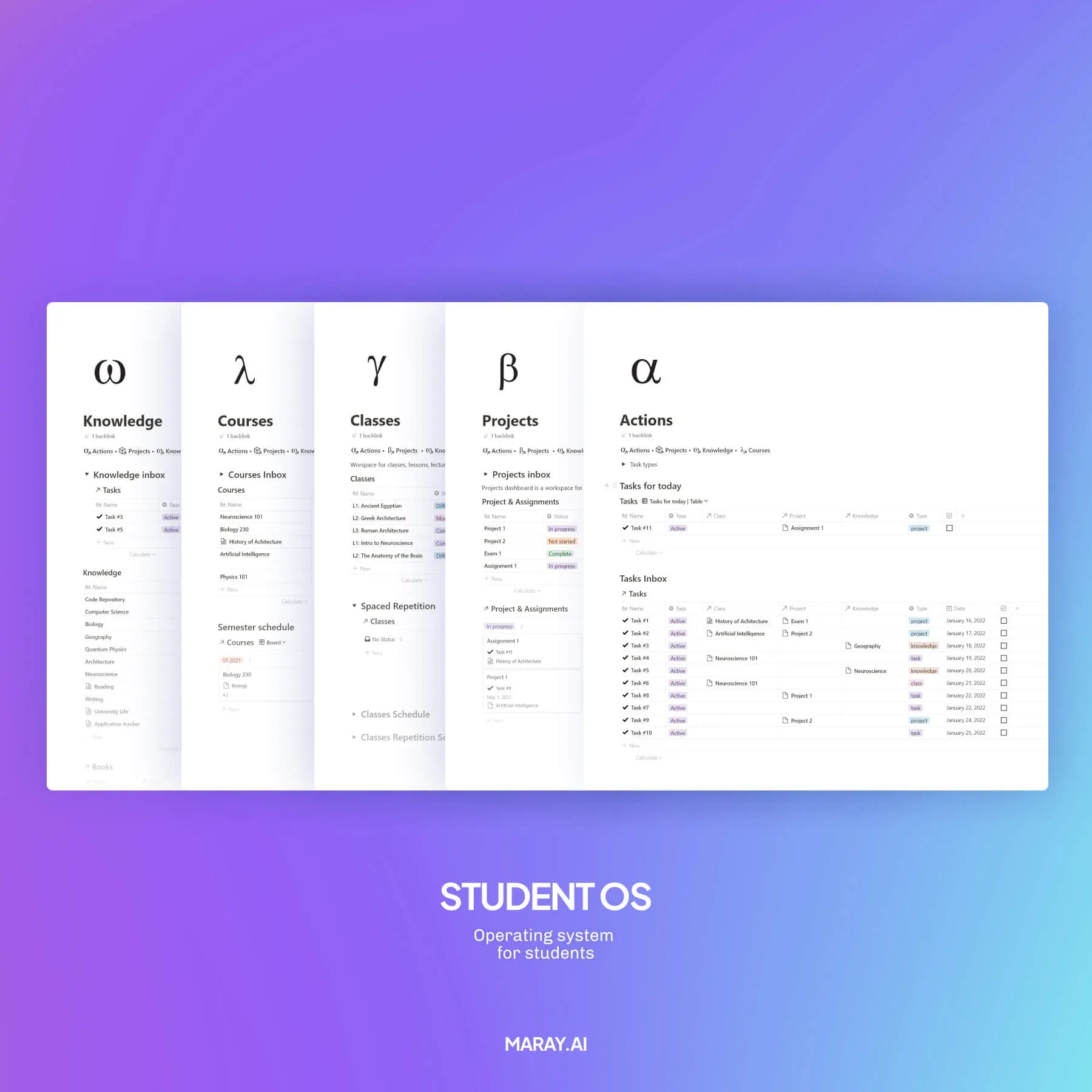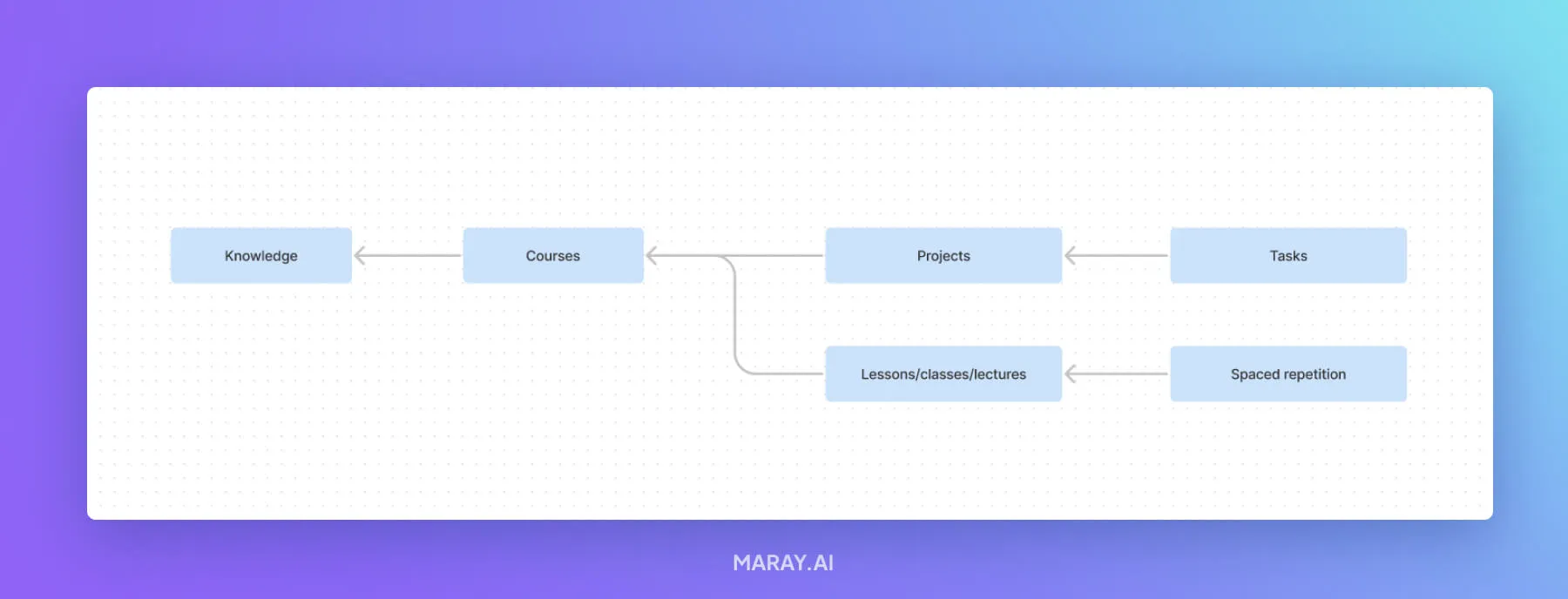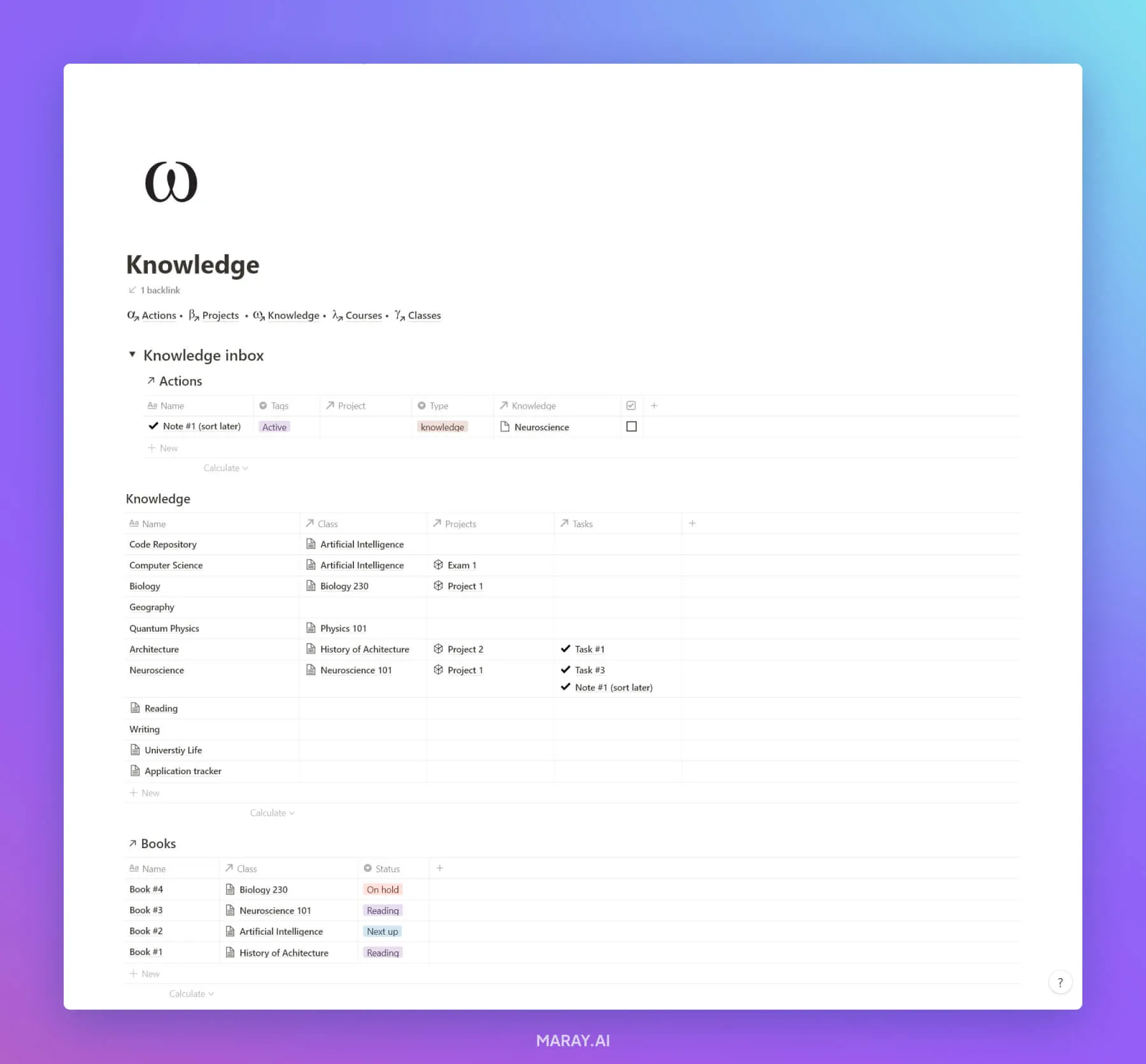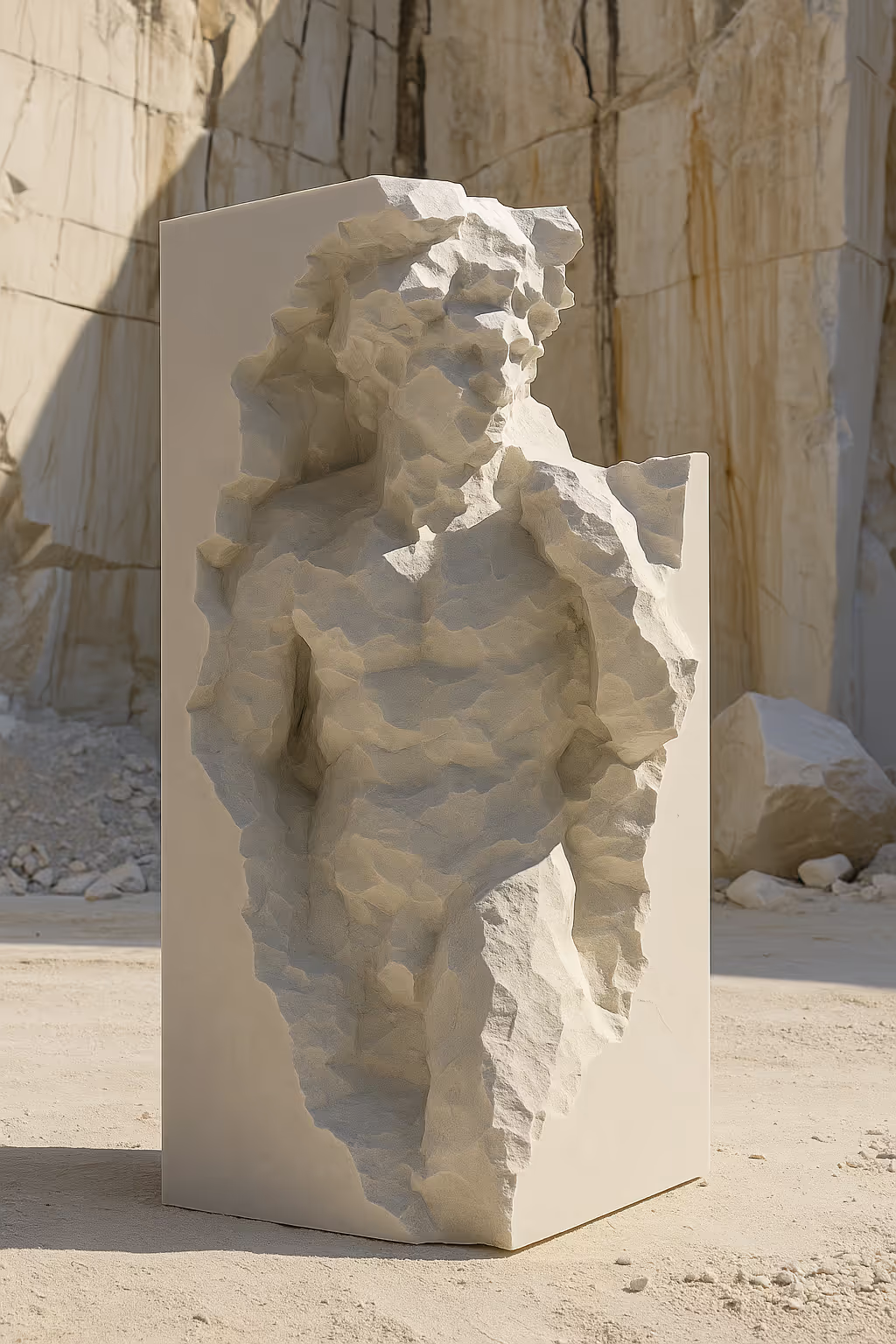Notion is an excellent tool for creating various productivity systems, especially for students. When I was a students, I could only imagine a system where I can organize my entire student life: my studies, assignments, class notes and projects. Now Notion and similar tools allow to builld simple systems that can reduce procrastination or help to be disciplined.
Student OS can help you plan your time, keep track of the classes, work on the assignments, improve retention and create a digital brain. Its main goals are to optimize the learning experience, increase productivity, save time and keep things organized. It can help you to even change your behavior, with a habit or two.
When I read Atomic Habits and learned about goals systems, I built my own productivity system that helped so much to go from daydreaming to specific actions towards my goals. I believe the same principles can work in a slightly different operating system for students.
In this blog post, I’ll explain how an operating system for students can be beneficial, how it can make learning more efficient, and how different parts of the system work.

## Why use an operating system for studying?
When I was an undergrad student, I used to procrastinate, miss deadlines, and stress about it and that led to an unhealthy study and life balance.
The problem was I didn’t have a proper system and a structure to organize my learning process. Nobody taught me how to build habits and change my behavior. I lacked a system to drive consistent changes and progress. Although I graduated with honors, my life was full of stress, sleepless nights until my thesis work was complete.
At that time I thought setting goals and dreaming about some perfect future life was enough. But I was wrong. I had a goal to make the most out of my time at uni like everyone else, but I didn’t know it wasn’t enough. My behavior and my goals were not aligned. I kept doing the same thing every year: procrastinating until the deadline was so close that the fear of failure and anxiety would overtake and lead to a 1-2 week of a stressful time. Two months later the same thing would happen.
I had to build certain habits to change my behavior and to achieve my goals.
A couple of years ago I learned how productivity systems and habit building help achieve your goals. Instead of repeating the same behavior, you change it by building certain habits. The system makes the process more consistent. Instead of changing your behavior for a week when you feel inspired, you do it in smaller steps but so many times until it’s part of you.
Since then I built a [Life OS](https://www.maray.ai/posts/life-operating-system-v2) for my personal life and side projects. It helped to finally make progress and lead a meaningful goal-oriented life. I also shared the system, the story, and the steps I took on my blog and it resonated with so many people.
Once the core principles proved to be working I came up with an idea to translate them into other areas of life, such as studying. Although identity building in studying, life, and work is similar, there are also different elements in play.
## What are the benefits of using an operating system?
The goal of the system is to make your life happier by making learning more efficient, reducing stress and anxiety, and creating a study/life balance.
Here are at least 5 benefits you can find in building an operating system to organize your studies.
### Benefit #1. Change your behavior
The biggest benefit I found is that an OS can change your day-to-day life. One of the key elements in changing behavior is to build habits that support your goals. That’s why I included a habit tracker in the system.
Let’s say you lack discipline and your goal is to improve your performance. You can start working on that by building a habit. It shouldn’t be big. Just enough to perform it consistently.
When I started this blog, I set a habit of writing and working on my projects for at least 30-60 minutes a day. It resulted in a lot of work being done. I published around 50 blog posts, grew the blog to 15,000 pageviews/month, learned a lot about website building and SEO, published a dozen of templates and launched 10 digital products, and earned ~$7000 in passive income.
The system and a few small habits, and some work on the weekend, brought outcome I wasn’t expecting. If you improve each day by a small amount, it can compound a lot in just 1 year. You can read my store in more detail [here](https://www.maray.ai/posts/life-operating-system-v2).
So you might ask, why do I need an operating system if I can use a habit tracker. That small habit, of course, was crucial. But the other parts, such as project and task management, made the process a lot easier. And several templates linked together in a coherent way make them a system.
### Benefit #2. K**eep things organized**
The system and a few rules keep things organized. I love to keep my digital life in order. I am the type of person who names his files consistently with a predefined pattern. However, I try to make the system as simple as possible. After all, using it is a habit, and the simpler it is, the easier it will stick.
That’s why I organize the core elements on separate dashboards and link them on the favorites sidebar for quick access. I usually started my day with a journal dashboard where I track my habits and do [morning journaling](https://www.maray.ai/posts/daily-journal-in-notion). Then I check my daily agenda on my Actions dashboard. When I need to check anything related to my projects, I either search or go there and find what I need. I know what’s where and it saves time.
When things are organized, you spend less time on finding things, maintenance, and actual work. You’ll have a clear overview of your schedule, to-dos, coursework. You’ll always be aware of the assignments you have to complete, the projects you work on, and so on. We’ll get to the structure of the OS in a sec.
### Benefit #3. Increase consistency and productivity
When I was an undergrad student, I was productive only close to the deadline. I used to work on my studio design projects and coursework when the anxiety kicks in.
Now I divide big projects into smaller steps and plan my work so that I don’t stress about these big tasks. Planning, when done right, makes execution easier.
It can also reduce your procrastination by reducing friction. Once you build a habit of using the OS and streamlining your workflow, everything would come easier as well.
### Benefit #4. Optimize the learning process
It can optimize the learning process in several ways.
First, you’ll make the learning process easier by having all the critical information, such as research and notes, in one place.
Second, you can learn by [practicing spaced repetition](https://www.maray.ai/posts/my-favorite-way-to-learn-and-retain-knowledge) to increase retention.
Third, when it’s time to prepare for exams, you’ll have *all* the information from classes and studies.
### Benefit #5. Build a second brain
With some maintenance, you’ll build a second brain just by studying and using the OS. By the time you graduate you will have built a second brain.
The more you add to your second brain, the more value you create in the long term. You’ll also always have access to your notes, insights, assignments, projects, and so on. You can productize your knowledge and expertise in the future.
[Here](https://www.maray.ai/posts/notion-knowledge-management-system) and [here](https://www.maray.ai/posts/my-favorite-way-to-learn-and-retain-knowledge) I discuss the benefits of building a knowledge base.
**To summarize, here are the benefits you can gain using a system for studying:**
Behavior
- Increase consistency by reducing friction.
- Reduce procrastination by simplifying and streamlining workflow with templates.
Productivity
- Keep things organized and clear.
- Plan and track your courses schedule.
- Create and manage projects and assignments.
- Plan, track and execute your tasks.
Learning
- Schedule spaced repetition to increase retention.
- Prepare for exams with *all* the information from classes and studies.
Second brain
- Keep a history of your studies.
- Collect and access a database of anything you create, learn, find and read any time in the future.
- Capture knowledge from lessons, take and organize notes.
## Student OS template
It is my desire to share my knowledge, insights, and experience for free. You can recreate the system following this and other blog posts I've written during the last year.
###### If you want to **save time and support my work**, you can purchase [the Student OS template](https://maray.gumroad.com/l/student-os/1ejfg30) and start right away. I've spent many hours researching the topic, building the prototype, testing it, writing the blog post to share insights and save you time. The launch price is 50% off for the first 25 copies.
If it doesn't work for you for some reason, you can always reach out so that we can figure out the obstacle together.
## Structure of the Student OS
The system is divided into the following parts:
1. Knowledge
2. Courses
3. Classes
4. Projects
5. Actions
6. Habits


I’ll go into each element and explain the idea behind it and how it works in the system as a whole.
## Knowledge
School is a perfect time to start building your second brain. Second brain is a digital system for collecting, storing, and accessing information. Modern tools like Notion and Obsidian made building a second brain easy and fun task. You can read more about [building a second brain](https://www.maray.ai/posts/second-brain) in a blog post I wrote earlier.
Knowledge management is crucial for students. After all, learning is the primary reason for attending schools and universities. It’s one of the essential elements in the Student OS. Courses, projects, and actions have a connection with the `Knowledge` database.
Here’s an example. Let’s say I study Computer Science and I create an entry in the database. This entry will become my central repository for everything related to CS: various courses, projects, assignments, notes, and tasks. When I take a CS 101 class, I link it to the CS `Knowledge` database entry. When I do a project, I can link it to the course or directly to the `Knowledge` database. I can also assign tasks to pages in the `Knowledge` DB if I need to.
The knowledge DB is also a place to save information related to other different topics: life, school, memes, or personal notes. If you study to be a developer, you can store your code snippets to build a repository. If you study in a medical school, you can create a repository of drugs or pathologies. If you study literature, you can benefit from creating a comprehensive books database to keep track of your reading list. Speaking of the reading list, the `Courses` database has a link to the `Books` database so that you can track your reading assignments.
`Knowledge` dashboard has an inbox too. It can be useful when you want to quickly take a note. Later you can put it on the page it belongs to.
Over the years you’ll have a clear overview of what you’ve done and learned on different subjects. Digital brain requires some maintenance but you’ll gain a lot of benefits in return in the future.
I discuss the benefits of knowledge management system [in this blog post](https://www.maray.ai/posts/notion-knowledge-management-system) in more depth.

## Courses
`Courses` dashboard is the next element of the OS. It is the space to plan and track the courses you take. Courses have relations to `Knowledge`, `Classes`, `Projects`, `Tasks`, and `Reading list`.
Once you create a course you can apply a template that creates linked databases to show you lessons related to that course only. Here you can add and manage class notes, track the schedule, and exercise spaced repetition.


## Classes/Lectures/Seminars
`Classes` is a dashboard where you can manage the classes you attend, check the schedule, plan spaced repetition and take notes.

## Projects
The concept of projects also comes from GTD. Projects are defined as something that takes more than 2-3 tasks to complete. So it’s a workspace for short-long-term activities: projects, papers, assignments, and exams. Here you can track tasks, manage projects, track their status and work on them.

## Actions
Actions is a dashboard to track your day-to-day activities. The dashboard is divided into 3 parts: your actions for today, actions inbox, and recent projects and classes.
`Actions for today` is your daily agenda. Here you can track your to-do items, plan and schedule.
`Actions inbox` is the place to capture anything from tasks to study notes. In fact, almost every other dashboard has a relevant inbox. Your action items will stay in the inbox unless you meet one of the following conditions:
1. Mark as completed
2. Leave either Class, Project, or Knowledge field empty.
3. The date you want to work on it is on or after tomorrow
If you want to learn more about task management, I explain the concept of GTD and how I use it as part of my productivity system in [this blog post](https://www.maray.ai/posts/gtd-notion) in more detail.

## Habits
`Habits` are a powerful way of changing your behavior. I wish I knew it when I was young. The lack of knowledge made me repeat the same mistakes over and over until I learned the framework from Atomic Habits.
I started building healthy habits in late 2020 and I can see the results of them now. At first, I didn’t really see progress because the habits are small and hence the name — atomic. That’s because consistency is more important than quality. However, now, I can see the progress I’ve made. I feel healthier, I reduced procrastination, and, more importantly, I feel happier.
The habits you are going to build should target your goals. First, identify the obstacle to your goals and then build or break habits to target it.
I use habits as part of my productivity and Life OS. I wrote a blog post about [building habits and a Habit Tracker in Notion](https://www.maray.ai/posts/notion-habit-tracker). There you can find the framework that I use and various neuroscience-based tips to make the process easier.

## How to use the dashboards
I prefer to keep my dashboards clean and to the point. That’s why each core element of the system has its own dashboard. I pin them in the favorites and I can quickly access whatever I need.
There’s also a navigation bar on the top of each page to quickly access different dashboards.
If you prefer, you can add links, other databases, different views, and so on. Customize it to your needs and preference.
In [this blog post](https://www.maray.ai/posts/notion-dashboards), I discuss how I arrange and use my Life OS dashboards.
## University/College application tracker
As a bonus, I thought it would be helpful to integrate a university application tracker.
The tracker gives you an overview of the schools you applied to, the status, priority, a template to keep the application-related documents in order.
The last time I applied to universities, I used to organize the applications in files and folders. Now it’s much more convenient to have a page for each application where you can store important information, a check list and relevant links.
## Note-taking in Student OS
I think the most important goal in note-taking is speed. That’s why I implemented an inbox for note-taking and capturing information on each dashboard.
Let’s say you take notes during a class, then you can open the `Classes` dashboard, make a new entry in the inbox, take notes and then later clean it up and assign a repetition date. That way you can quickly capture your notes and you won’t forget to clean them and organize them properly later.
Alternatively, if it’s a note for your Knowledge DB, you can use the inbox there. If you don’t know where to put it, you can use the inbox on the actions dashboard and decide later.
###### If you want to **save time and support my work**, you can purchase [the Student OS template](https://maray.gumroad.com/l/student-os/1ejfg30) and start right away. I've spent many hours researching the topic, building the prototype, testing it, writing the blog post to share insights and save you time. The launch price is 50% off for the first 25 copies.
## Final thoughts
Student OS is a system to make your learning experience more optimized. It can save you time, improve your productivity, and create life-long value.
I hope you learned something new today. You can join our [community of learners on discord](https://discord.gg/g3pvMKbT2v) and [follow me on Twitter](https://twitter.com/ayk_martirosyan) for similar content.





